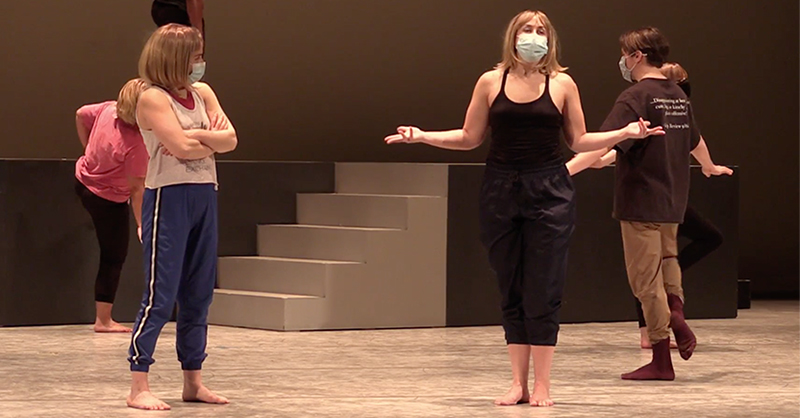Inspired by the ways in which COVID-19 has transformed what it means to learn and work in the performing arts, Performing Your Art in a Pandemic invites C-U performing arts students to share their experiences, be they frustrating, surprising, or inspiring. If you have suggestions, ideas, or feedback, feel free to contact us at [email protected].
Most choreographers know to steel themselves for whatever unexpected production issues might crop up during a piece’s creation—a dancer who gets injured, a costume that works in theory but not onstage, a movement phrase that may have been created in a spacious rehearsal studio but must now be adapted for a tiny black box theater. The pandemic, of course, threw all of those potential problems into sharp relief: What happens when dancers can’t be within a few feet of each other, let alone touch?
As a third-year dance MFA candidate at the University of Illinois, I’ve gotten to grapple firsthand with what it means to choreograph during a pandemic. Since August, I’ve been creating my choreographic thesis, which will premiere in the dance department’s March Dance concert on Saturday, March 20th. Twice a week for the last eight months, I’ve rehearsed in a studio (or, on occasion, on Zoom) with my fellow 10 cast members, shaping a work that draws on a quirky late ’90s television show, Ally McBeal, as well as some more dense material, like feminist narrative theory, the dangers of white feminism, and what a non-linear narrative might look like within a dance setting.
Back in August, maintaining a six-foot distance between my dancers at any given moment seemed less a choreographic disadvantage than a general nuisance. I’d come into rehearsal, armed with ideas of intricate spacing and interactions, only to realize that much of what I’d pictured had failed to take the necessary gaps of space between bodies into consideration. I felt frustrated in those moments, and, on occasion, would allow myself to briefly wallow in self-pity, conjuring up some imagined, more excellent version of my dance that would never see the light of day, thanks to COVID-19 and its seemingly infinite restrictions.
Over time, though, I saw my movement preferences and ideas start to take a decided shape: Almost without realizing it, my choreography began to read as more two-dimensional, like a fancy 360-degree photo that had been compressed and then stretched out into an extra-wide comic strip panel. My dancers and I found new ways to create tension and relationship across wider swaths of space. I began to truly explore the depth of a proscenium stage, seeing what kind of juxtapositions could take shape in the fore and background of a theatrical space.
I also knew I wanted spoken text and song to be a part of my thesis—I was imagining it as a pseudo-musical, you might say, but one with dance as its anchor, rather than music or dialogue. Masks, as you might guess, make it difficult to understand what someone’s saying or singing. I counted on that, but what I hadn’t planned for was that it would be difficult for an audience to tell exactly who was speaking or singing at any given moment, since our mouths would be covered. My solution was to ask the dancer singing or speaking to affect a cartoonish bobble-head, like a dashboard figurine in overdrive, to draw attention to their utterances.
Eventually, I—like probably many of my dance peers—began to forget what a pre-COVID choreographic experience felt like. Simultaneously grateful and greedy for the in-person dancing I got to do (thanks to the ever-diligent dance department), I experienced, almost without realizing it, all the familiar trappings of any choreographic undertaking: excitement for what we were generating in the studio; eager to collaborate with the scenic, lighting, and media designers who would help my project come to life; nervous to premiere a piece that had been nearly a school year in the making. Like any worthy choreographic venture, the pandemic had forced me to approach its restrictive measures with creativity and invention, and the piece I’ve now created is indelibly shaped by the last year of quarantine-lite life we’ve all lived. In my more generous moments, I like to think that my work is better because of it. (Though, admittedly, when I’m frustrated, I still give myself over to a few minutes’ worth of wallowing, mourning the dance I never got to create.)
In many ways, I’ve lived a pretty privileged pandemic existence—I’ve attended and taught class in-person, rehearsed consistently, watched (and performed in!) a live concert last November, and been consistently supported by a community of dancers, teachers, peers, and friends. I know I’m exceedingly fortunate to be making art in a pandemic, and I think that’s worked its way into my thesis, too. Maybe I’m imagining it, but I think there’s a new expansiveness in the way I create, or even in the way I think about making art, and that’s had ripple effects on the movement and work I make.
Oh, and I’m starting to see the light at the end of the pandemic tunnel! In Tuesday’s ballet class, we got to do a combination across the floor—moving in space!—for the first time since mid-March 2020. Things are looking up.








